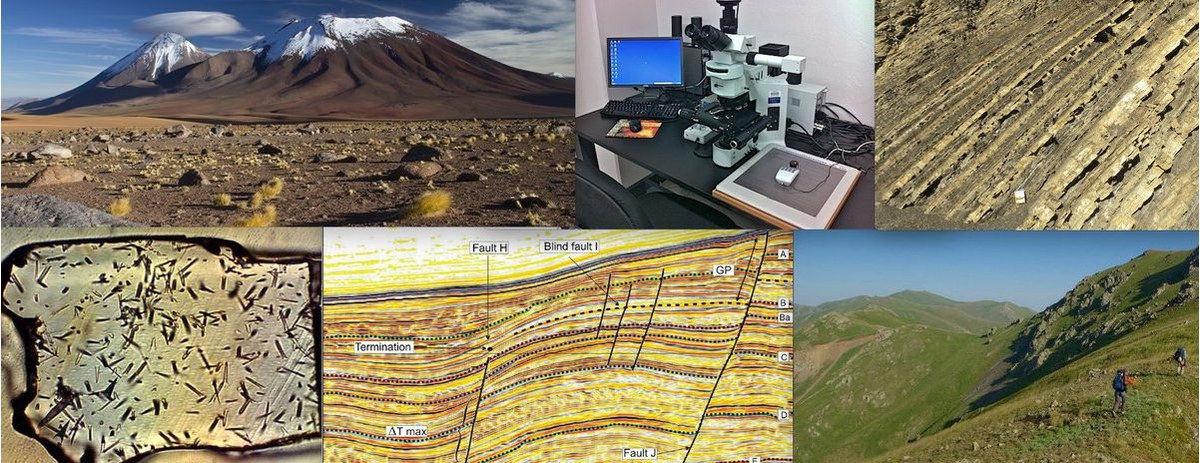Sedimentary basin analysis and thermochronology

Sedimentary basins are regions of long-term subsidence creating accommodation space to be filled by sediments. The study of sedimentary basins as specific entities in themselves is referred to as sedimentary basin analysis. The need to understand the processes of basin formation and evolution is not purely academic as sedimentary basins are the location for virtually all of the world's hydrocarbon and water reserves and host a variety of important mineral deposits; as such they are the focus of intense industrial interest. In addition, sedimentary basins can be genetically linked to orogens nearby and may provide unique datasets toward a thorough comprehension of orogenic belts.
This multidisciplinary line of research integrates (i) stratigraphy, (2) sedimentology, (3) structural analysis, (4) low-temperature thermochronology [fission-track and (U-Th)/He analyses], and (5) sedimentary petrology to provide compelling constraints on the relationships between tectonism and sedimentary basin formation/development. Tipically, investigations carried out within this framework imply the integration of large datasets of both academic and industrial provenance with new data obtained from key areas previously neglected. Through the years, research projects have involved numerous foreign institutions (Acad. Sci. Armenia, Bulgarian Acad. Sci., BRGM, Carleton Univ., ETH, Geophys. Inst. (Tbilisi), IFP, ITU, LANL, Stanford Univ., UCLA, Univ. Arizona, Baku State Univ., Univ. Basel, Univ. Edinburgh, Univ. Lausanne, Univ. Texas-Austin, UPMC), industries (ARCO, BRGM, Chevron, Conoco, Elf, ENI, Exxon, Petrobras, Shell, Sonatrach, Total), international organizations and initiatives (IGCP, IUGS, NATO, UNESCO), and Italian institutions (CNR, ENEA, Univ. Florence, Univ. Padua, Univ. Rome).
Our laboratory has a long tradition in the development of techniques for rock-forming mineral separation and microscopic modal analyses (Gazzi-Dickinson point-counting method), with particular applications to sedimentary petrology. The fission-track laboratory at the University of Bologna was the first of this type in an Italian university. Initially the laboratory focused on research on the northern Apennines and the Alpine orogenic wedge of Italy and France, and progressively broadened its scope undertaking research in areas including the Chilean Andes, the Anatolian-Iranian plateau, and the Caucasus, among others. Current lines of research -in cooperation with Italian and foreign institutions- include (i) the analysis of far-field stress transmission from the Bitlis-Zagros collision zone toward the Eurasian hinterland, including structural inversion of sedimentary basins (Turkey, Georgia, Azerbaijan, Armenia and Iran), (ii) the thermochronometric analysis of the Menderes and Alanya massifs of SW Turkey within the framework of the overall transition from a compressional (Eocene) to an extensional (Oligocene-Miocene) regime over the entire Aegean and peri-Aegean region, (iii) the structural analysis of the Strandja Massif (SE Bulgaria and NW Turkey) in the attempt to resolve the superposed effects of the Cimmerian and Alpine orogenic cycles, and (iv) the study of Alpine-age ductile shear zone affecting the Variscan basement complex of western Corsica (France).
Link:
The TRANSMED Atlas - The Mediterranean Region from Crust to Mantle
PeriTethyan Rift/Wrench Basins and Passive Margins
Four Centuries of the Word "Geology"
Selected references
- Cavazza, W., Albino, I., Zattin, M., Galoyan, G., Imamverdiyev, N. and & Melkonyan, R. (2015): Thermochronometric evidence for Miocene tectonic reactivation of the Sevan-Akera suture zone (Lesser Caucasus): a far-field tectonic effect of the Arabia-Eurasia collision? Geological Society of London Special Publication 428, doi: 10.1144/SP428.4.
- Cavazza et al. [ten authors] (2014): Low-temperature thermochronologic trends across the central Andes, 21°S–28°S. Geological Society of America Memoires, 212:215-249.
- Cavazza et al. [fourteen authors] (2014): Paleotectonics of a complex Miocene half graben formed above a detachment fault: The Diligencia basin, Orocopia Mountains, southern California. Lithosphere, 6:157-176.
- Cavazza, W., Federici, I., Okay, A.I., and Zattin, M. (2012): Apatite fission-track thermochronology of the Western Pontides (NW Turkey). Geological Magazine, 149:133-140.
- Cavazza, W., and Barone, M. (2010): Large-scale sedimentary recycling of tectonic mélange in a forearc setting: the Ionian basin (Oligocene-Quaternary, southern Italy). Geological Society of America Bulletin, 122:1932-1949.
- Okay, A.I., Zattin, M., and Cavazza, W. (2010): Apatite fission-track data for the Miocene Arabia-Eurasia collision. Geology, 38:35–38.
- Cavazza, W., DeCelles, P.G., Fellin, M.G., and Paganelli, L. (2007): The Miocene Saint-Florent Basin in Northern Corsica: Stratigraphy, sedimentology, and tectonic implications. Basin Research, 19:507-527.
- Cavazza, W., and Ingersoll, R.V. (2005): Detrital modes of the Ionian forearc basin fill (Oligocene-Quaternary) reflect the geodynamic evolution of the Calabria-Peloritani terrane (southern Italy). Journal of Sedimentary Research, 75:268-279.
- Cavazza, W., Roure, F., Spakman, Stampfli, G.M., and Ziegler, P.A., eds. (2004): The TRANSMED Atlas: the Mediterranean Region from Crust to Mantle. Heidelberg, Springer-Verlag, 141 pp. + CD-ROM.
- Ziegler, P.A., Cavazza, W., Robertson, A.H.F., and Crasquin-Soleau, S., eds. (2001): Peritethyan Rift/Wrench Basins and Passive Margins: Mém. Muséum Nat. Hist. Nat., Paris, v. 186, 762 p.
- Stampfli, G., Borel, G., Cavazza, W., Mosar, J., and Ziegler, P.A., eds. (2001): The Paleotectonic Atlas of the PeriTethyan Domain (CD-ROM). European Geophysical Society.
- Cavazza, W., and DeCelles, P.G. (1998): Upper Messinian siliciclastic rocks in southeastern Calabria (southern Italy): paleotectonic and eustatic implications for the evolution of the central Mediterranean region. Tectonophysics, 298:223-241.
- Cavazza et al. [nine authors] (1996): The Mud Hills, Mojave Desert, California: structure, stratigraphy, and sedimentology of a rapidly extended terrane. Geological Society of America Special Paper 303:61-84.
- Cavazza, W., and DeCelles, P.G. (1993): Miocene submarine canyons and associated sedimentary facies in southeastern Calabria, southern Italy. Geological Society of America Bulletin 105:1297-1309.
- Ingersoll, R.V., Cavazza, W., Baldridge, W.S., and Shafiqullah, M. (1990): Cenozoic sedimentation and paleotectonics of north-central New Mexico: implications for initiation and evolution of the Rio Grande rift. Geological Society of America Bulletin 102:1280-1296.